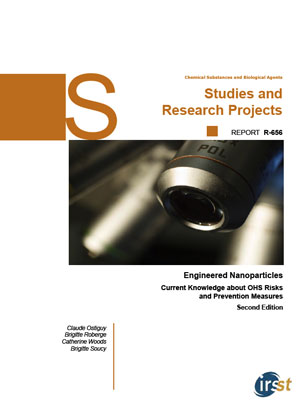| Posted: Sep 21, 2010 |
|
New report on engineered nanoparticle risk
|
|
(Nanowerk News) IRSST,the Quebec-based Institut de recherche Robert-Sauvé en santé et en sécurité du travail, has released the second edition of its report "Engineered Nanoparticles: Current Knowledge about Occupational Health and Safety Risks and Prevention Measures".
|
|
An initial review of the literature on nanoparticles prompted the IRSST to publish two reports on this subject early in 2006, namely on the health risks of nanotechnologies and on various aspects of industrial hygiene that involve them. Considering the rapid evolution in scientific knowledge, they have now release this update (pdf) to the initial reports.
|
 |
|
Summary
|
|
An initial assessment of the state of scientific knowledge about the occupational health and
safety aspects (OHS) related to synthetic nanoparticles (NP) was published by the IRSST in 2006
and covered the scientific literature until the end of 2004. What was found was that OHS
knowledge was very fragmentary but that research in this field was rapidly growing. This current
document aims to assess the state of current knowledge in this field and summarizes the data
available until early 2010.
|
|
Overall, what emerges is that NP remain an important source of concern in OHS. In fact, not
only does the diversity of commercially available chemical products of nanometric dimensions
continue to increase, but also, the information available about the hazards specific to these
substances is still very fragmentary. The literature gives us very little information specific to NP
relating to their physical hazards like fires or explosions. As for health hazards, many
toxicological studies on different substances have demonstrated toxic effects on various organs.
It is found that in general, an NP will normally be more toxic than the same chemical substance
of larger dimensions, but it is currently impossible to determine which measuring parameter for
exposure is best correlated with the measured effects. The evaluation of occupational exposure
must therefore address a series of different parameters, and the exposure data available are
relatively rare. It should also be noted that at the present time, attention is particularly focused on
carbon nanotubes (CNT), which seem to show, in different animal studies, toxicity similar to that
of asbestos and consequently causing great concern in the international scientific community,
mainly relating to prevention.
|
|
In a context of incomplete data for the majority of nanometric substances, it remains impossible
to quantify the risks for workers in the majority of situations because the toxicity of the products,
the level of dust contamination of workplaces, or their potential to cause fires or explosions
remain not extensively documented or totally undocumented. Nevertheless, the majority of the
means of exposure control for ultrafine particles should be effective against NP and much
research is currently being carried out to confirm this.
|
|
In a context of uncertainty about the risks, and with an increasing number of potentially exposed
workers, the current report paints a big picture of the OHS knowledge currently available in the
NP field. In the absence of specific standards, a preventive and even a precautionary approach
are recommended, and a review of the available means for minimizing worker exposure is
presented. The needs for developing new knowledge are enormous and the authors propose some
avenues of research that they feel are a priority in the current Québec context.
|

